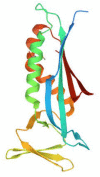Computational Studies on 6-Pyruvoyl Tetrahydropterin Synthase (6-PTPS) of Plasmodium falciparum
- PMID: 38333003
- PMCID: PMC10851736
- DOI: 10.1177/11779322241230214
Computational Studies on 6-Pyruvoyl Tetrahydropterin Synthase (6-PTPS) of Plasmodium falciparum
Abstract
6-Pyruvoyl tetrahydropterin synthase (6-PTPS) is a lyase involved in the synthesis of tetrahydrobiopterin. In Plasmodium species where dihydroneopterin aldolase (DHNA) is absent, it acts in the folate biosynthetic pathway necessary for the growth and survival of the parasite. The 6-pyruvoyl tetrahydropterin synthase of Plasmodium falciparum (PfPTPS) has been identified as a potential antimalarial drug target. This study identified potential inhibitors of PfPTPS using molecular docking techniques. Molecular docking and virtual screening of 62 compounds including the control to the deposited Protein Data Bank (PDB) structure was carried out using AutoDock Vina in PyRx. Five of the compounds, N,N-dimethyl-N'-[4-oxo-6-(2,2,5-trimethyl-1,3-dioxolan-4-yl)-3H-pteridin-2-yl]methanimidamide (140296439), 2-amino-6-[(1R)-3-cyclohexyl-1-hydroxypropyl]-3H-pteridin-4-one (140296495), 2-(2,3-dihydroxypropyl)-8,9-dihydro-6H-pyrimido[2,1-b]pteridine-7,11-dione (144380406), 2-(dimethylamino)-6-[(2,2-dimethyl-1,3-dioxolan-4-yl)-hydroxymethyl]-3H-pteridin-4-one (135573878), and [1-acetyloxy-1-(2-methyl-4-oxo-3H-pteridin-6-yl)propan-2-yl] acetate (136075207), showed better binding affinity than the control ligand, biopterin (135449517), and were selected and screened. Three conformers of 140296439 with the binding energy of -7.2, -7.1, and -7.0 kcal/mol along with 140296495 were better than the control at -5.7 kcal/mol. In silico absorption, distribution, metabolism, excretion, and toxicity (ADMET) studies predicted good pharmacokinetic properties of all the compounds while reporting a high risk of irritant toxicity in 140296439 and 144380406. The study highlights the five compounds, 140296439, 140296495, 144380406, 135573878 and 136075207, as potential inhibitors of PfPTPS and possible compounds for antimalarial drug development.
Keywords: Molecular docking; Plasmodium falciparum 6-pyruvoyl tetrahydropterin synthase; antimalarial drugs; drug targets; potential inhibitors.
© The Author(s) 2024.
Conflict of interest statement
The author(s) declared no potential conflicts of interest with respect to the research, authorship, and/or publication of this article.
Figures







Similar articles
-
Probing the Structural Dynamics of the Plasmodium falciparum Tunneling-Fold Enzyme 6-Pyruvoyl Tetrahydropterin Synthase to Reveal Allosteric Drug Targeting Sites.Front Mol Biosci. 2020 Sep 25;7:575196. doi: 10.3389/fmolb.2020.575196. eCollection 2020. Front Mol Biosci. 2020. PMID: 33102524 Free PMC article.
-
Tetrahydrobiopterin biosynthetic pathway and deficiency.Enzyme. 1987;38(1-4):302-11. doi: 10.1159/000469220. Enzyme. 1987. PMID: 3326735 Review.
-
Three-dimensional structure of 6-pyruvoyl tetrahydropterin synthase, an enzyme involved in tetrahydrobiopterin biosynthesis.EMBO J. 1994 Mar 15;13(6):1255-62. doi: 10.1002/j.1460-2075.1994.tb06377.x. EMBO J. 1994. PMID: 8137809 Free PMC article.
-
Biosynthesis of tetrahydrobiopterin. Purification and characterization of 6-pyruvoyl-tetrahydropterin synthase from human liver.Eur J Biochem. 1986 Dec 1;161(2):295-302. doi: 10.1111/j.1432-1033.1986.tb10446.x. Eur J Biochem. 1986. PMID: 3536512
-
The pathway from GTP to tetrahydrobiopterin: three-dimensional structures of GTP cyclohydrolase I and 6-pyruvoyl tetrahydropterin synthase.Biol Chem. 1997 Mar-Apr;378(3-4):185-92. Biol Chem. 1997. PMID: 9165069 Review.
Cited by
-
Core-genome guided novel therapeutic targets identification and chimeric vaccine designing against Rickettsia rickettsii.Sci Rep. 2025 Jan 6;15(1):921. doi: 10.1038/s41598-024-83395-3. Sci Rep. 2025. PMID: 39762342 Free PMC article.
-
Targeting invasion-associated proteins PfSUB2 and PfTRAMP in Plasmodium falciparum: identification of potential inhibitors via molecular docking.BMC Infect Dis. 2025 Aug 19;25(1):1038. doi: 10.1186/s12879-025-11380-w. BMC Infect Dis. 2025. PMID: 40830840 Free PMC article.
-
Molecular Docking Appraisal of Pleurotus ostreatus Phytochemicals as Potential Inhibitors of PI3K/Akt Pathway for Breast Cancer Treatment.Bioinform Biol Insights. 2025 Feb 3;19:11779322251316864. doi: 10.1177/11779322251316864. eCollection 2025. Bioinform Biol Insights. 2025. PMID: 39906062 Free PMC article.
References
-
- WHO. World malaria report 2022; 2022. https://www.who.int/teams/global-malaria-programme.
-
- Arrow KJ, Panosian C, Gelband H. Antimalarial drugs and drug resistance. In: Saving Lives, Buying Time: Economics of Malaria Drugs in an Age of Resistance. National Academies Press; 2004. https://www.ncbi.nlm.nih.gov/books/NBK215631/. Accessed May 9, 2023. - PubMed
LinkOut - more resources
Full Text Sources

